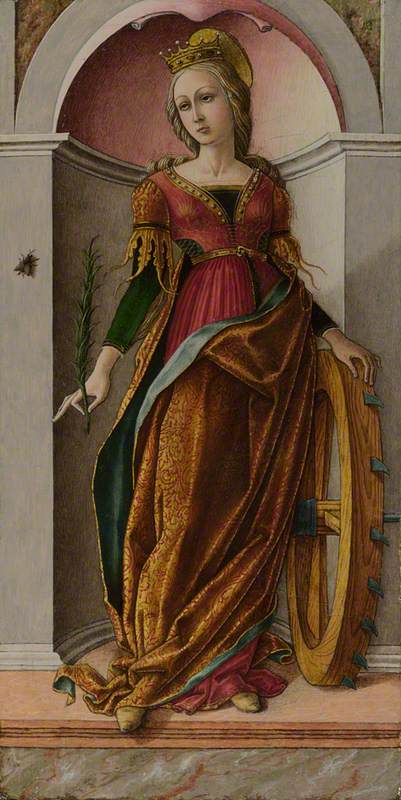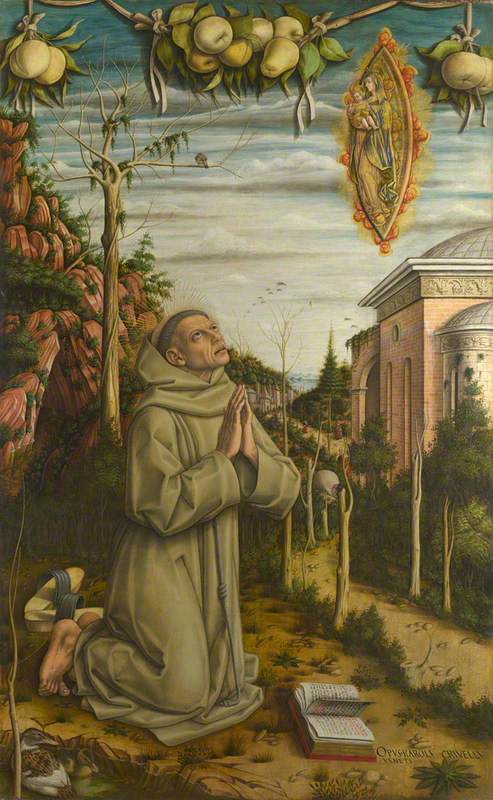There are cracks everywhere in Carlo
Crivelli’s works; beautifully rendered trompe l’oeil fissures in rocks,
masonry, even the earth itself. Perhaps he was just recording the reality of
life in Italy’s earthquake-prone Marche. Perhaps they are symbolic of worldly
imperfection like the oversized fly that is plaguing his St Catherine of
Alexandria (c.1490s). Ironically, they also foretell his own fate, for
Crivelli slipped through the cracks of art history, ignored by Vasari in his
famous Lives, and side-lined ever since. Ikon Gallery’s small but
jewel-like exhibition aims to redress the balance. Director Jonathan Watkins is
a self-confessed Crivelli fan, who, thanks to generous loans from the National
Gallery and a £150,000 grant from the Ampersand Foundation has created ‘Shadows
on the Sky’, an exhibition as weird and wonderful as Crivellis it shows.
Relieved of Renaissance context, exhibited like a contemporary artist on
spacious white walls and placed in conversation with a Susan Collis
installation, Crivelli is revealed, not as a conservative dead-end, but as
playfully, cleverly experimental.
But Crivelli is not just about
oddness. As his Victorian enthusiasts appreciated, he was lover of
craftsmanship whose paintings zing with colour, detail, texture. His Venetian
roots ran deep: he never abandoned Byzantine gold and followed Vivarini in
exploiting three-dimensional pastiglia. You can only imagine how the panels would
look glinting in candlelight, shining through incense filled gloom. He relishes
rich damasks, intricate rugs, the precision of a peacock’s tail, a carnation, a
glinting pearl. Detail piles on detail, a surfeit of visual sensation which
creates a better than, fuller than, more beautiful than life, world; a visual
heaven to which the faithful aspire and which the saints already inhabit. There’s
an International Gothic eye for elongated line: Byzantine fingers pluck at serpentine
folds, immaculate curls frame alabaster-skin faces. But Crivelli is no head in
the sand has-been; he has Mantegna’s love of classical decoration and overhyped
perspective.
Britain is blessed with Crivellis,
thanks mainly to a buying spree by the National Gallery in the 1860s, and he
was a prolific artist. The small, sparse show in Birmingham gives the opposite
impression. You can take your time and get up close in a way which their normal
hang in the Sainsbury Wing at the National Gallery doesn’t allow; and the vast,
glorious, jaw-dropping Annunciation with St Emidius (1486) is hung so low you could almost walk into
it. Take time to get to know Saint Roch (c.1480), normally relegated to a dark
corner of the Wallace Collection. With careful tempera hatching, Crivelli
creates detail and character: the hollowed cheeks and drawn skin, the plain
pilgrim’s grab and yet underlying breeding and elegance; the hand raised
in surprise and wonder as he reveals plague wound from which he has been cured.
But these works were never intended be seen in splendid isolation. Most are
hacked up altarpieces, meant to be crammed together between elaborate gilt,
figures interacting, jostling for attention in competitive martyrdom. Their
religious intensity, already dimmed by a secular world, is further reduced by
the clinical setting. It’s a small quibble. Crivelli is a joy, and Birmingham,
at present suffering the prolonged closure of its art gallery, is enjoying his
presence.





No comments:
Post a Comment